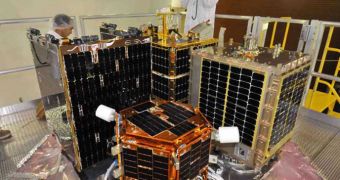Officials at the United States Air Force (USAF) announce that they will launch a new space mission today, November 19, during which the military will attempt to demonstrate a number of new technologies that have never flown to space before.
The flight, dubbed STP-S26, will include seven satellites carrying a number of 16 different scientific experiments. All of them have finished processing, and are now integrated atop a Minotaur 4 delivery system, awaiting launch tonight.
Among the technologies that the Air Force will attempt to demonstrate in the coming weeks are a new type of command and control system, spacecraft deployment and propulsion systems, as well as new atmospheric sensors.
According to Lt. Col. Tim Cole, who is the launch vehicle program manager for STP-S26, the Minotaur 4 rocket will take off at 8:24 pm EST (0124 November 20 GMT), from the Kodiak Launch Complex, in Alaska.
The launch is a part of the USAF Space Test Program, which has launched 25 similar missions thus far. All experimental payloads that various agencies of the US government launch into space are coordinated from this center.
The delivery system contains a number of three cubesat-class spacecrafts, which weigh only a few kilograms each. The other four satellites are about as large as a refrigerator each, and weigh around 180 kilograms.
All of them will launch on the Minotaur 4 system, which is built by the Dulles, Virginia-based Orbital Sciences Corporation (OSC). Thrust will be provided by three solid rocket motors from Peacekeeper intercontinental ballistic missiles (ICBM) and a Orion 38 solid rocket motor.
The latter is developed by Minneapolis, Minnesota-based Alliant Techsystems (ATK), a company that has been working with NASA in constructing and testing rocket engines for many years.
This particular rocket is a new player on the market. It was inaugurated in April, when it flew a suborbital sortie, and then it completed its first orbital test flight in September. The USAF is taking a risk launching such a payload on a rocket that has been in use for such a short time.
A new aspect that will separate this mission from others is that the delivery system will place its payloads in two different orbits. It will first reach an altitude of 650 kilometers above the Earth's surface, and then deploy the satellites.
After that, it will climb to 1,100 kilometers, where it will deliver a dummy payload, in order to test a new separation system that was developed by the Boeing Company, Space reports.

 14 DAY TRIAL //
14 DAY TRIAL //